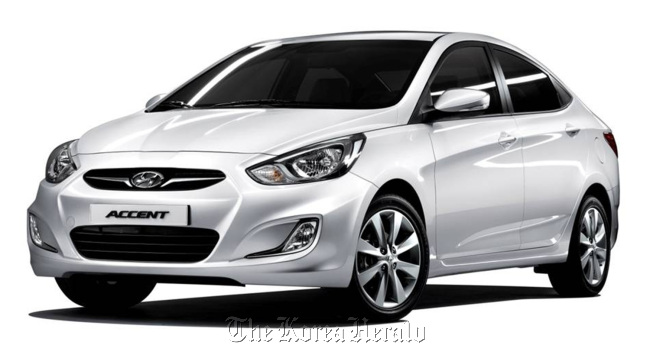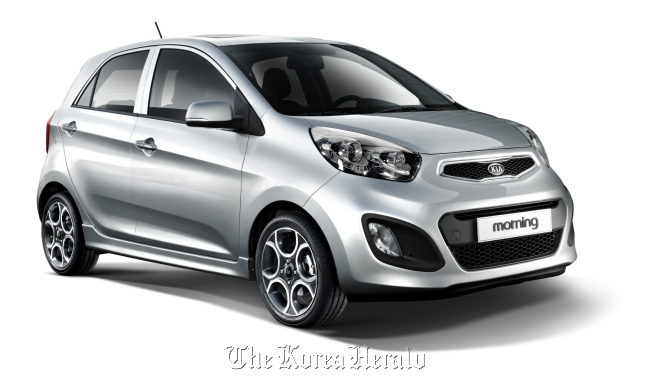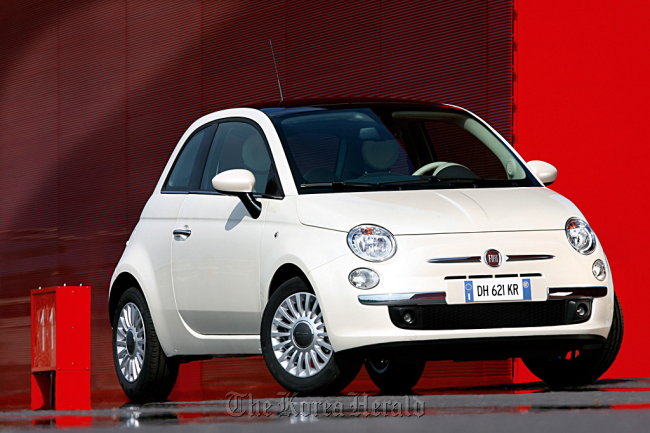Local carmakers eager to ride the boom while import car brands remain cautiousThe nation’s economic slowdown is turning consumers toward small-sized cars, a trend likely to continue during the second half of this year, according to experts and government officials.
Auto analysts said the 20-year-old small car market is growing bigger than ever, selling 124,450 compact and sub-compact cars in the first seven months of this year with a 15 percent growth on-year.
They said the market has a high chance of further growth, given that domestic carmakers sold about 185,130 compact and sub-compact cars last year.
Although five domestic automakers suffered about a 5.7 percent drop in year-on-year sales growth on average from January through July this year, Hyundai Motor Co., the nation’s top carmaker, managed to keep its sales steady, with a slight on-year growth in July of 0.1 percent.

Hyundai Accent
Hyundai Motor reported that its monthly sales of sub-compact car Accent in July, 2012, made a steep increase to 3,200, which translates to 25.2 percent growth month-on-month and 18.5 percent growth year-on-year.
“The small car sales were decent last year as well, but we are selling even more small cars this year,” a Hyundai Motor spokesman said.
“Roughly speaking, two cars out of every 10 cars sold were small-sized cars last year. This year, three out of every ten cars sold were compact and sub-compact cars.”
As the company that sells most small cars in Korea, Hyundai attributed the rising popularity of small cars to their improved performance and design, and a new trend of households wanting multiple cars.
“Most people think compacts are ‘entry-cars’ for young drivers, but that’s really not the case these days. Young people mostly choose semi-medium-sized or medium-sized cars as their first cars,” the spokesman said.
“The market trend is taking after that of the U.S. More and more households want multiple cars. They tend to buy low-cost compacts as secondary cars so that other family members can share.”
Besides lower tax and gasoline costs ― advantages to compacts since the start of the compact market ― small cars have advanced in design, performance and safety.
The colors have diversified. Kia Motors’ sub-compact Morning added pink, azure blue and mint green to its traditional array of colors.
In the past, small cars were significantly lower-performing since their “compact size” limited the space for auto parts, the Hyundai spokesman said. Putting in more parts to increase performance means a larger size and heavier weight, which fundamentally lowers fuel efficiency.
“Car parts have become lighter and smaller, and now we can fit many more parts into compacts for better performance.”
For example, about a decade ago, small cars were not equipped with power windows because the function required extra room for electrical cords, switches and other supplementary devices.

Kia Morning

Fiat 500
Compact cars tend to have a better field of vision than medium- and large-sized cars, adding to driver safety.
“Compact cars’ windshields are more vertical than larger vehicles, and their hoods and backs are shorter. That means drivers can get a better sense of relative distance from other cars.”
Imported car brands are divided over whether to introduce their small-sized cars into the soaring Korean market.
Toyota Korea told the Korea Herald that the company currently has no plan to import small-sized cars.
Such a move contrasts with Toyota’s announcement on Aug. 10 that it will aim to double its sales in Brazil within two years. Toyota opened its third Brazilian factory for Etios compact, and has announced plans to build its fourth Brazilian plant for engine manufacturing.
“We see that the compact car market in Korea is still small, considering domestic demand for imported cars,” a Toyota spokeswoman said, stressing that the country’s auto market still revolves around larger cars, mentioning the BMW 5 series and Lexus.
“The price merit is essential in these compacts. Imported compacts will come in a higher price range because of additional costs like tariffs, shipping costs and so on, but we see the market is not mature enough that customers would pay more for imported compacts.”
Currently all Toyota cars sold in Korea are manufactured in Japan, with the exception of the Camry and Sienna, which are produced in the U.S.
Japanese automaker Nissan said that it currently has no plan to release compact cars in the Korean market because of expected low profit margins.
Italian carmaker Fiat, the major shareholder of U.S. automaker Chrysler Group LLC, is active in introducing Italian-style sub-compact cars to the Korean car market.
The Fiat-Chrysler Group announced on Aug. 8 that its three signature models, two of which are small-sized ones ― Fiat 500 and Fiat 500C ― will make their Korean debuts in 2013.
These two Fiat compacts have 1,400 cubic-centimeter engines, like Citroen’s DS3. BMW Mini cars run on either 1,600 or 2,000 cc engines.
Fiat-Chrysler was optimistic about these models, saying that the cars have the stylish, distinguished design that fits the taste of young drivers in their twenties and thirties.
The Korea units of Mercedes-Benz, BMW and Audi plan to roll out compact cars between the second half and next year, according to a local daily.
The report says that BMW will put its five-door hatchback 120d on sale in October. Focusing on practicality, the hatchback can exert a maximum 184 horsepower and has an 8-speed automatic transmission, automatic start-stop system and 23.3 kilometer-per-liter fuel efficiency.
Mercedes-Benz will introduce new A class model with a 1,796 cubic-centimeter engine. The compact is capable of 109 horsepower and 24.4 kilometer-per-liter fuel efficiency.
The launch date is still being arranged between Mercedes-Benz Korea and the German headquarters. The Korean unit is trying its best to introduce the car around the second half of 2013, the vernacular daily said.
Audi Korea is also discussing the launch date of A1 1.6 TDI, which has a 1.6-liter diesel engine, 105 horsepower maximum capacity and 25.5 kilometer-per-liter fuel efficiency.
Audi Korea said that A1 can enter the Korean market as early as this year once the company and the German headquarters reach an agreement on the price.
By Chung Joo-won (
joowonc@heraldcorp.com)








